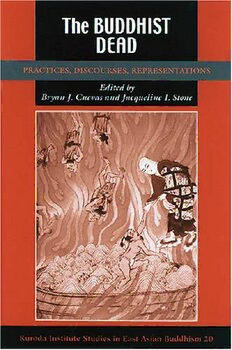
The Buddhist Dead: Practices, Discourses, Representations PDF
505 Pages·2007·5.77 MB·English
Most books are stored in the elastic cloud where traffic is expensive. For this reason, we have a limit on daily download.
Preview The Buddhist Dead: Practices, Discourses, Representations
Description:
In its teachings, practices, and institutions, Buddhism in its varied Asian forms has been--and continues to be--centrally concerned with death and the dead. Yet surprisingly ''death in Buddhism'' has received little sustained scholarly attention. The Buddhist Dead offers the first comparative investigation of this topic across the major Buddhist cultures of India, Sri Lanka, China, Japan, Tibet, and Burma. Its individual essays, representing a range of methods, shed light on a rich array of traditional Buddhist practices for the dead and dying; the sophisticated but often paradoxical discourses about death and the dead in Buddhist texts; and the varied representations of the dead and the afterlife found in Buddhist funerary art and popular literature.The paradigmatic figure of the historical Buddha, his death, the symbolism of his funeral, and his relationship to the impurity of the dead are treated in the opening essays by John S. Strong and Gregory Schopen. The deaths of later remarkable adepts, following the Buddha's model, and their significance for Buddhist communities are investigated by Koichi Shinohara, Jacqueline I. Stone, Raoul Birnbaum, and Kurtis R. Schaeffer. A dramatic, often controversial category of exemplary death, that of ''giving up the body'' or Buddhist suicide, is examined by James Benn and D. Max Moerman. Moving from celebrated masters to ordinary practitioners and devotees, Bryan J. Cuevas, John Clifford Holt, and Matthew T. Kapstein take up the subject of the ''ordinary dead'' and the intimate relations that often persist between them and those still living, while Hank Glassman, Mark Rowe, and Jason A. Carbine shed light on Buddhist funerary practices and address the physical and social locations of the Buddhist dead.This important collection moves beyond the largely text- and doctrine-centered approaches characterizing an earlier generation of Buddhist scholarship and expands its treatment of death to include ritual, devotional, and material culture. Its foundational insights are both culturally and historically grounded and at the same time offer a basis for further, comparative conversations on death between scholars of Buddhism and other religious traditions.
See more
The list of books you might like
Most books are stored in the elastic cloud where traffic is expensive. For this reason, we have a limit on daily download.
